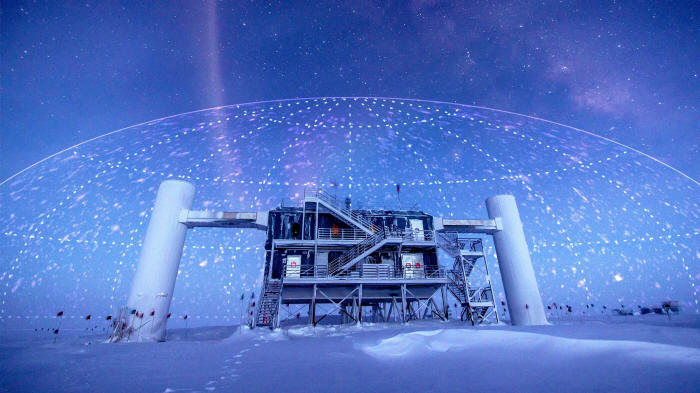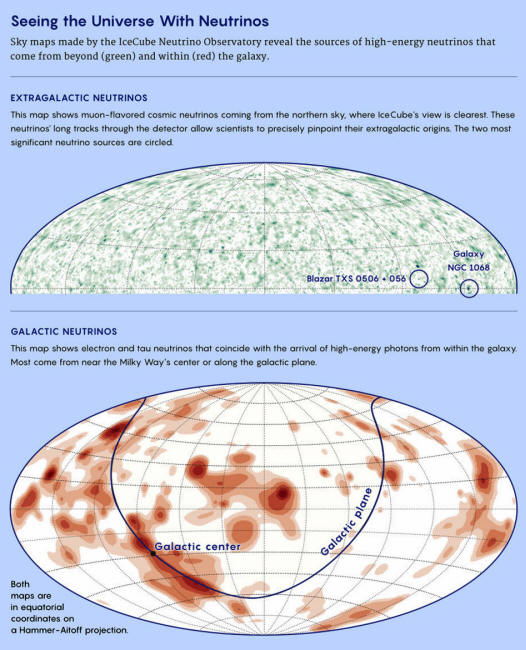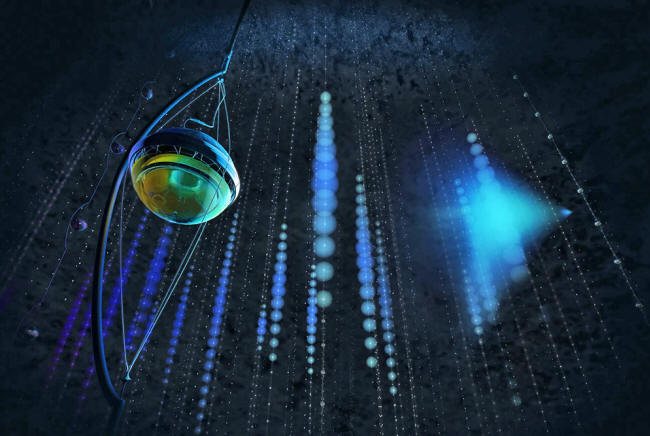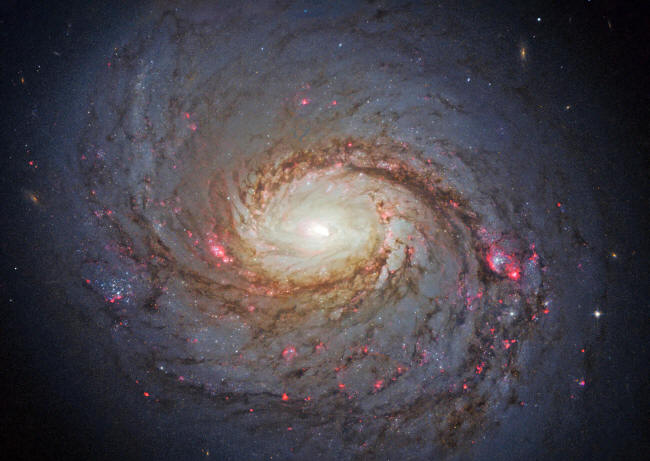|
the IceCube Neutrino Observatory at the South Pole has detected a dozen or so
cosmic
neutrinos each year.
images
courtesy of IceCube Collaboration
Physicists finally know where at least some of these high-energy particles come from, which helps make the neutrinos useful for exploring fundamental physics...
But a smattering of the particles - those moving much faster than the rest - traveled here from powerful sources farther away. For decades, astrophysicists have sought the origin of these "cosmic" neutrinos.
Now, the IceCube Neutrino Observatory has finally collected enough of them to reveal telltale patterns in where they're coming from.
In a paper published today in Science, the team revealed the first map of the Milky Way in neutrinos. (Usually our galaxy is mapped out with photons, particles of light.)
The new map shows a diffuse haze of cosmic neutrinos emanating from throughout the Milky Way, but strangely, no individual sources stand out.
The results follow an IceCube study from last fall, also in Science, that was the first to connect cosmic neutrinos to an individual source.
It showed that a large chunk of the cosmic neutrinos detected so far by the observatory have come from the heart of an "active" galaxy called NGC 1068.
In the galaxy's glowing core, matter spirals into a central supermassive black hole, somehow making cosmic neutrinos in the process.
Pinpointing cosmic neutrino sources opens up the possibility of using the particles as a new probe of fundamental physics.
Researchers have shown that the neutrinos can be used to open cracks in the reigning Standard Model of particle physics and even test quantum descriptions of gravity.
Yet identifying the origin of at least some cosmic neutrinos is only a first step.
Little is known about how the activity around some supermassive black holes generates these particles, and so far the evidence points to multiple processes or circumstances.
Merrill Sherman/Quanta Magazine; images courtesy of IceCube Collaboration
Long-Sought Origin
Abundant as they are, neutrinos usually zip through Earth without leaving a trace; a magnificently huge detector had to be built to detect enough of them to perceive patterns in the directions they arrive from.
IceCube, built 12 years ago, consists of kilometer-long strings of detectors bored deep into the Antarctic ice.
Each year, IceCube detects a dozen or so cosmic neutrinos with such high energy that they clearly stand out against a haze of atmospheric and solar neutrinos.
More sophisticated analyses can tease out additional candidate cosmic neutrinos from the rest of the data.
Astrophysicists know that such energetic neutrinos could only arise when fast-moving atomic nuclei, known as cosmic rays, collide with material somewhere in space.
And very few places in the universe have magnetic fields strong enough to whip cosmic rays up to sufficient energies.
Gamma-ray bursts, ultrabright flashes of light that occur when some stars go supernova or when neutron stars spiral into each other, were long thought one of the most plausible options.
The only real alternative was active galactic nuclei, or AGNs - galaxies whose central supermassive black holes spew out particles and radiation as matter falls in.
The gamma-ray-burst theory lost ground in 2012, when astrophysicists realized that if these bright bursts were responsible, we would expect to see many more cosmic neutrinos than we do. Still, the dispute was far from settled.
Then, in 2016, IceCube began sending out alerts every time they detected a cosmic neutrino, prompting other astronomers to train telescopes in the direction it came from.
The following September, they tentatively matched up a cosmic neutrino with an active galaxy called TXS 0506+056, or TXS for short, that was emitting flares of X-rays and gamma rays at the same time.
More and more cosmic neutrinos were collected, and another patch of sky began to stand out against the background of atmospheric neutrinos.
In the middle of this patch is the nearby active galaxy NGC 1068.
IceCube's recent analysis shows that this correlation almost certainly equals causation. As part of the analysis, IceCube scientists recalibrated their telescope and used artificial intelligence to better understand its sensitivity to different patches of sky.
They found that there's less than a 1-in-100,000 chance that the abundance of neutrinos coming from the direction of NGC 1068 is a random fluctuation.
Statistical certainty that TXS is a cosmic neutrino source isn't far behind, and in September, IceCube recorded a neutrino probably from the vicinity of TXS that hasn't been analyzed yet.
An illustration of IceCube's interior during a detection. When a neutrino interacts with molecules in the Antarctic ice, it produces secondary particles that leave a trace
of blue light as they travel through the detector.
The Physical Mechanism
These two AGNs appear to be the brightest neutrino sources in the sky, yet, puzzlingly, they're very different.
TXS is a type of AGN known as a blazar:
Yet we see no such jet pointing our way from NGC 1068.
This suggests that different mechanisms in the heart of active galaxies could give rise to cosmic neutrinos.
Halzen suspects there is some material surrounding the active core in NGC 1068 that blocks the emission of gamma rays as neutrinos are produced.
But the precise mechanism is anyone's guess.
The cosmic neutrinos originating in the Milky Way muddle things further.
There are no obvious sources of such high-energy particles in our galaxy - in particular, no active galactic nucleus. Our galaxy's core hasn't been bustling for millions of years.
Halzen speculates that these neutrinos come from cosmic rays produced in an earlier, active phase of our galaxy.
What stands out in the new image of the sky is the intense brightness of sources like NGC 1068 and TXS.
The Milky Way, filled with nearby stars and hot gas, outshines all other galaxies when astronomers look with photons.
But when it's viewed in neutrinos,
Setting the Milky Way mystery aside, astrophysicists want to use the farther, brighter sources to study dark matter, quantum gravity and new theories of neutrino behavior.
IceCube has detected dozens of neutrinos coming from NGC 1068, also known as Messier 77 - an active galaxy located 47 million light-years away. The well-studied galaxy, imaged here by
the Hubble Space Telescope, is visible with large binoculars.
Probing Fundamental Physics
Neutrinos offer rare clues that a more complete theory of particles must supersede the 50-year-old set of equations known as the Standard Model.
This model describes elementary particles and forces with near-perfect precision, but it errs when it comes to neutrinos:
Physicists discovered in 1998 that neutrinos can shape-shift between their three different types;
And in order to shape-shift, neutrinos must have mass - the oscillations only make sense if each neutrino species is a quantum mixture of three different (all very tiny) masses.
Dozens of experiments have allowed particle physicists to gradually build up a picture of the oscillation patterns of various neutrinos:
But cosmic neutrinos originating from AGNs offer a look at the particles' oscillatory behavior across vastly bigger distances and energies.
This makes them,
Cosmic neutrino sources are so far away that the neutrino oscillations should get blurred out - wherever astrophysicists look, they expect to see a constant fraction of each of the three neutrino types.
Any fluctuation in these fractions would indicate that neutrino oscillation models need rethinking.
Another possibility is that cosmic neutrinos interact with dark matter as they travel, as predicted by many dark-sector models. These models propose that the universe's invisible matter consists of multiple types of non-luminous particles.
Interactions with these dark matter particles would scatter neutrinos with specific energies and create a gap in the spectrum of cosmic neutrinos that we see.
Or the quantum structure of space-time itself can drag on the neutrinos, slowing them down.
A group based in Italy recently argued in Nature Astronomy that IceCube data shows hints of this happening, but other physicists have been skeptical of these claims.
Effects such as these would be minute, but intergalactic distances could magnify them to detectable levels.
Already, Argüelles-Delgado and collaborators have used the diffuse background of cosmic neutrinos - rather than specific sources like NGC 1068 - to look for evidence of the quantum structure of space-time.
As they reported in Nature Physics in October, they didn't find anything, but their search was hampered by the difficulty of distinguishing the third variety of neutrino - tau - from an electron neutrino in the IceCube detector.
What's needed is "better particle identification," said co-author Teppei Katori of King's College London. Research is underway to disentangle the two types.
Katori says knowing specific locations and mechanisms of cosmic neutrino sources would offer a "big jump" in the sensitivity of these searches for new physics.
The exact fraction of each neutrino type depends on the source model, and the most popular models, by chance, predict that equal numbers of the three neutrino species will arrive on Earth.
But cosmic neutrinos are still so poorly understood that any observed imbalance in the fractions of the three types could be misinterpreted.
The result could be a consequence of quantum gravity, dark matter or a broken neutrino oscillation model - or just the still-blurry physics of cosmic neutrino production. (However, some ratios would be a "smoking gun" signature of new physics, said Argüelles-Delgado.)
Ultimately, we need to detect many more cosmic neutrinos, Katori said. And it looks as though we will.
IceCube is being upgraded and expanded to 10 cubic kilometers over the next few years, and in October, a neutrino detector under Lake Baikal in Siberia posted its first observation of cosmic neutrinos from TXS.
And deep in the Mediterranean, dozens of strings of neutrino detectors collectively called KM3NeT are being fastened on the seafloor by a robot submersible to offer a complementary view of the cosmic-neutrino sky.
But,
|





